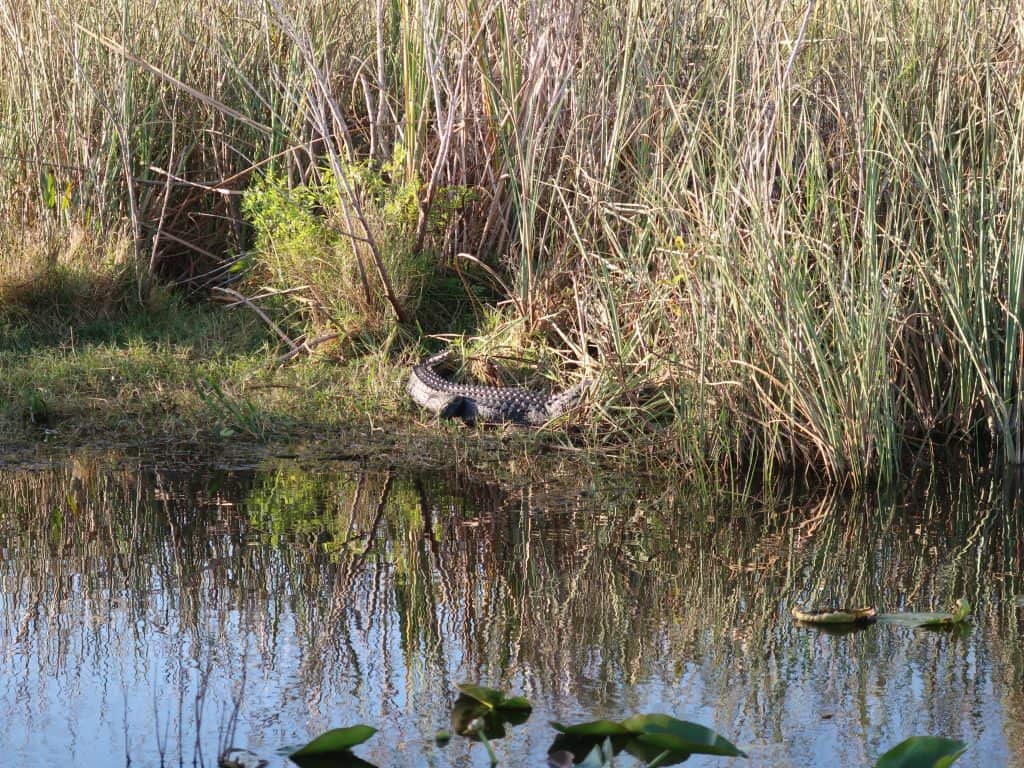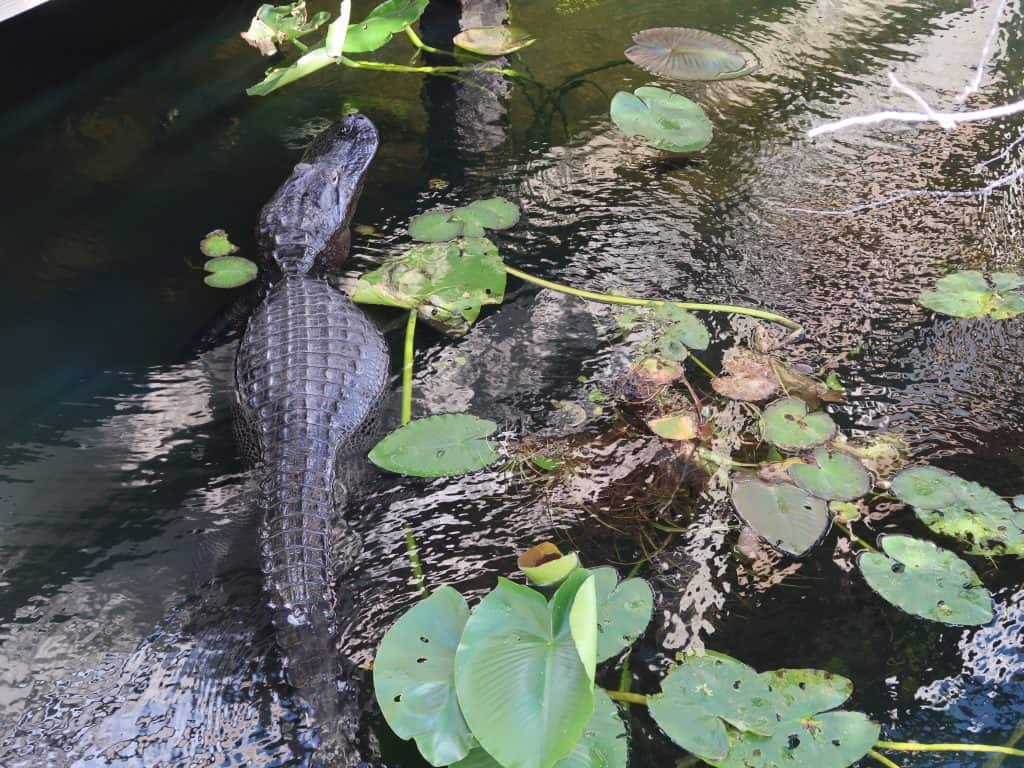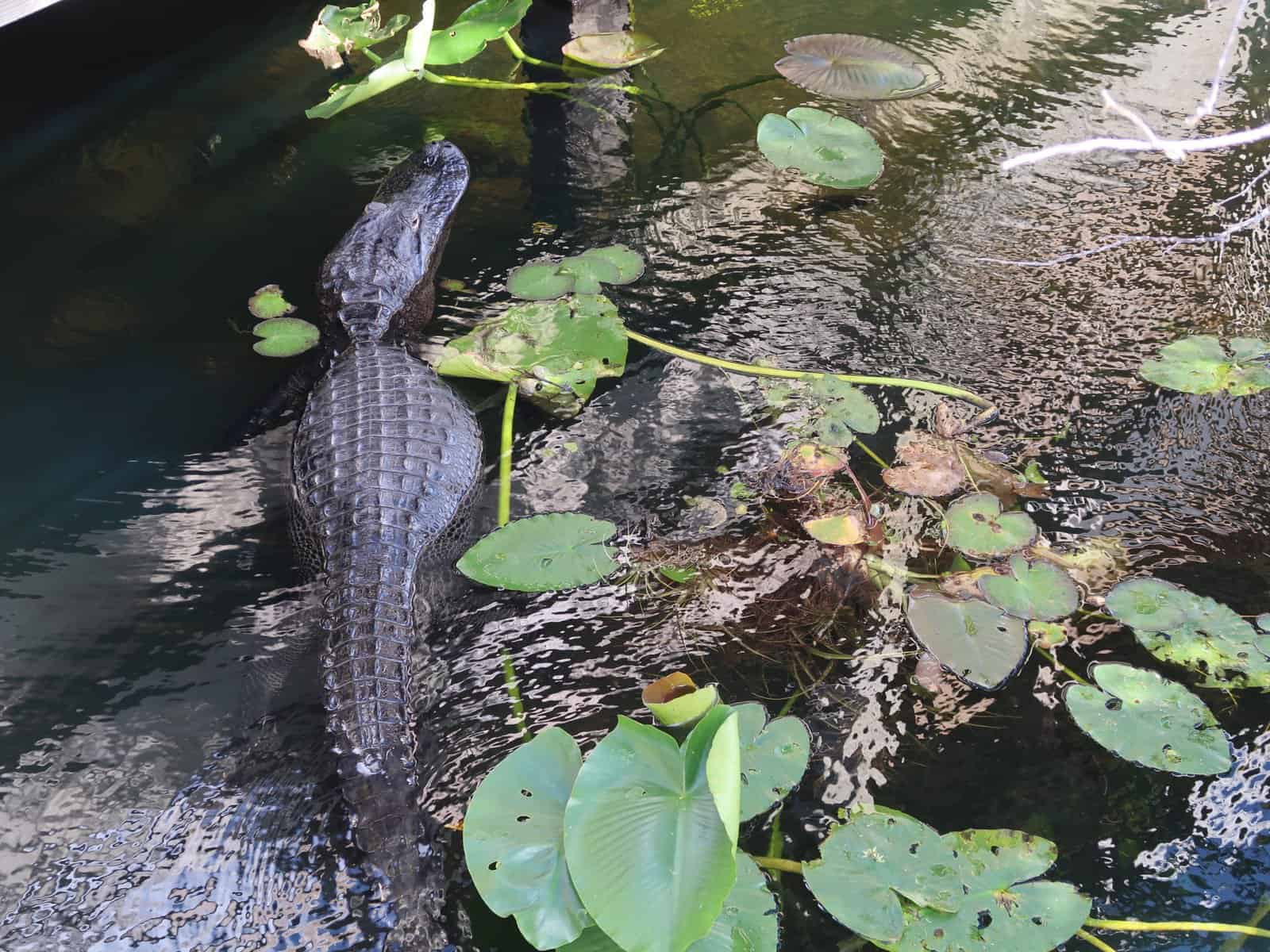Florida Everglades National Park, with its sprawling wetlands and diverse ecosystems, is known for its abundant wildlife including the iconic American alligator and the crocodile.
If you’re eager to witness these massive reptiles in their natural habitats, we’re sharing our best tips on how to find alligators and crocodiles in the Florida Everglades!

How to Find Alligators and Crocodiles in the Florida Everglades
The great news about wildlife viewing in the Florida Everglades is that you are guaranteed to have success! The truth is, however, that some species are easier to find than others. Expect to see alligators. Be grateful to see crocodiles.
Follow these tips to ensure you maximize your experience and see as many animals as possible.
1. Choose the Right Time of Year
The best time to spot alligators in the Florida Everglades is the subject of hot debate!
Some argue that the dry season, which typically runs from November to April, is preferable because water levels in the wetlands recede, concentrating alligators in the remaining water sources. Thus, they are left with fewer places to hide.
Others say that the wet season, April through November, is preferable due to the animals’ affinity for the hot, wet conditions.
The truth is that the Florida Everglades is a temperate climate with average daily highs ranging only from 76 degrees to 91 degrees no matter the month. Furthermore, the wetlands are wet year-round. While March often sees the lowest rainfall and late summer offers the most, the difference in the number of animals you might see is likely not worth the discomfort of the south Florida summer.
We suggest you make this visit in the winter. We saw numerous alligators and a crocodile on our last, January visit, and neither the temperatures nor the rain burdened our trip!
2. Explore the Right Areas
To maximize your opportunities for alligator sightings, focus on exploring the areas where they are commonly found within the Everglades National Park. The Shark Valley and Everglades City regions are known for their dense alligator populations.
Take advantage of the park’s hiking trails, boardwalks, and scenic drives, which provide access to prime alligator habitats such as freshwater marshes, sloughs, and canal systems.
Crocodiles, on the other hand, prefer brackish or saltwater habitats. These are typically found in coastal areas within the Everglades. To see crocodiles, focus your exploration on locations such as Florida Bay, the Ten Thousand Islands, and the coastal mangrove forests as they provide the ideal mix of freshwater and saltwater environments.
3. Take an Airboat or Boat Tour
One of the most popular and thrilling ways to see alligators in the Everglades is by taking an airboat or boat tour. These guided tours offer a unique opportunity to navigate the park’s waterways, providing a closer and more intimate encounter with alligators and other wildlife.
Knowledgeable guides can share fascinating insights about alligators’ behaviors, habitats, and the overall ecosystem of the Everglades.
While we have enjoyed our airboat tours, it is important to note that the noise of the boat can deter the animals. Learning about the birds and the flora is a better bet than alligator and crocodile viewing from the airboats.
4. Visit Alligator Hotspots
Certain areas within the Everglades are known as “alligator hotspots” due to their higher alligator populations. Pay a visit to popular spots like the Anhinga Trail in Royal Palm, where alligators can often be seen sunbathing along the water’s edge or swimming in the shallows.
This half-mile trail right outside of the Royal Palm Visitor Center should be your top priority when you’re searching for alligators within Florida Everglades. The boardwalk guides you along, and the animal life is as dense as a zoo trail! We do urge you to keep your kids close to you. There can be alligators very close to the trail.
Additionally, the Flamingo area near the southern tip of the park offers opportunities for alligator sightings, particularly in the waters surrounding the marina and campgrounds. Since this is a place where the salt water meets the fresh water, this is our favorite place to spot crocodiles!

5. Be Patient and Observant
When searching for alligators, patience and keen observation are key. Keep your eyes peeled for telltale signs such as alligator tracks or ripples in the water indicating their presence. Scan the banks of water bodies, particularly areas with vegetation or fallen logs where alligators often enjoy the sun.
Always look for protruding eyes and snouts above the water’s surface, as alligators are skilled at camouflaging themselves.
6. Maintain a Safe Distance
While observing alligators, it is crucial to maintain a safe distance to ensure both your safety and the well-being of the animals. Alligators are wild creatures and should never be approached, fed, or provoked.
Keep a minimum distance of at least 15 feet (4.5 meters) from alligators on land and even greater distances if they are in the water. Remember that alligators are swift and powerful, capable of surprising bursts of speed.
7. Respect Park Regulations
Always abide by the park’s regulations and guidelines for wildlife viewing. Follow any signage or instructions provided by park authorities. By respecting these rules, you contribute to the preservation of the Everglades’ delicate ecosystem and help protect the animals and their natural behaviors.
The Florida Everglades is, perhaps, our most delicate national park. Read more about its invasive species and how you can support this unique ecosystem.

8. Take A Deep-Dive into The Park!
The Florida Everglades National Park has so much to enjoy. Don’t visit with a primary intention of seeing alligators and crocodiles. We assure you that you will witness these creatures as a part of a more thorough adventure through the park. Read more about our top tips on what to do when you visit the Florida Everglades!
Enjoy the Alligators and Crocodiles in the Florida Everglades!
As you embark on your quest to spot alligators and crocodiles in the Florida Everglades, remember that it is a privilege to observe these ancient reptiles in their native environment. Treat these animals with the utmost respect and admiration, and cherish the memories you and your family create as you observe their lives in our Florida Everglades National Park!

